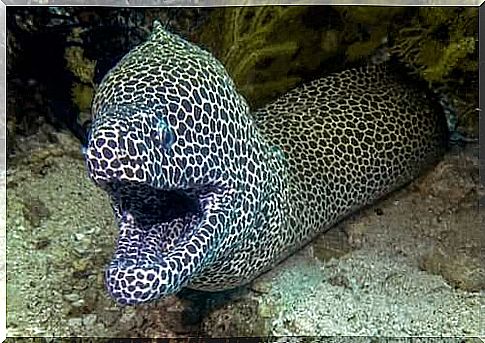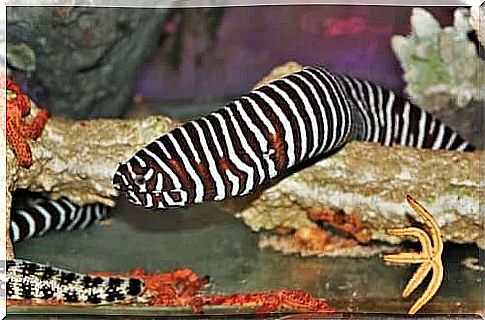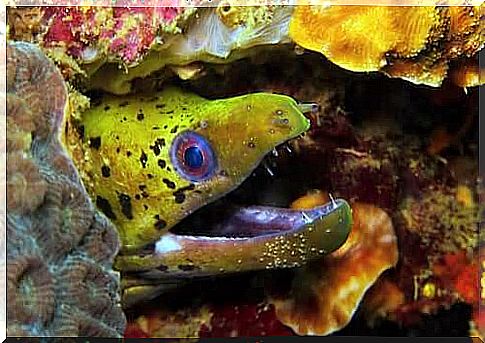Moray Eels And Their Incredible Pharyngeal Jaws

All the species belonging to the family of the moray eels ( Muraenidae Rafinesque ) are called morays . All the specimens have the characteristic appearance of the eel, that is, a long and cylindrical body. To date, about 200 species grouped into 16 genera are known.
The largest species, Strophidon sathethe , can reach four meters in length. These fish live in rock cavities and are carnivores. Thanks to a highly developed sense of smell, they are excellent hunters.
Without deserving it, these beautiful creatures have earned a reputation for being aggressive. This is due to the fact that they often open their mouths showing their teeth. However, this happens because they need to let in more water, as their gills are quite small.
Where do morays live?
We can define this family of cosmopolitan fish. Moray eels live between the surface of the sea and 100 meters deep.
They are known to spend most of their time hidden inside crevices and small caves. Most moray eel species live in warm waters and in regions where coral reefs are present.
These fish, therefore, live in tropical, subtropical and temperate seas. Many species of moray eels live in brackish water and very few marine species in fresh water.

How can we recognize moray eels?
As we said earlier, moray eels have an elongated and cylindrical body. They are characterized by the absence of fins and by the smooth skin without scales. They have a very narrow opercular slot, usually a simple hole.
Generally the skin color is brownish-purple or blackish, but tropical species have brighter and lighter colors. In some species, skin colors are also present inside the mouth.
These fish have a sturdy body and slightly compressed laterally, especially on the back. The head, short and massive and with a rounded profile, has from one to three lateral pores.
A particular feature of some moray eel species is the large mouth with numerous long, pointed teeth.
Are they as ferocious as they say?
Due to their appearance, moray eels are believed to be particularly aggressive fish. In reality, they only attack in self-defense when they feel threatened.
Moray eels are afraid of humans and prefer to flee rather than attack. They only attack when disturbed within their lair. In this case they react with strength and aggression.
Many of the attacks occur due to the scuba diving of tourists trying to give them food.
Moray eels have poor eyesight and mainly use their sense of smell to search for food. That’s why they hardly distinguish tourists’ fingers from food. For this reason, in some areas such as the Great Barrier Reef, diving for tourism purposes is prohibited.
Perhaps not everyone knows that the skin of moray eels is devoid of scales and is often prey to parasites. This is one of the reasons why these fish rub their bodies against divers and even seek caresses.
Are morays poisonous?
Although some species produce toxins, in some places it is customary to hunt moray eels for food. The toxin they produce is resistant to cooking and is called ciguatoxin.
This toxin causes food poisoning called ciguatera. In turn, ciguatera derives from the metabolism of another toxin, maitotoxin, produced by a dinoflagellate ( Gambierdiscus toxicus ) which is part of zooplankton.
When fish ingest dinoflagellate, the precursor toxin is metabolized and the resulting substance accumulates in the highest trophic levels.
According to experts, this mechanism could be an evolutionary response to threats from potential predators. It is interesting to know that in some species the toxin is secreted in the protective mucus of their skin.
The surprising pharyngeal jaw of the moray eels
The mouth of the moray eels is deep and has numerous teeth. In addition to the normal jaw edge teeth, many moray eel species have so-called pharyngeal jaws.
These jaws have no bone base and are supported only by muscle ligaments. They are very similar to the jaws and teeth of the mouth.
When feeding, moray eels advance their pharyngeal jaws into the oral cavity to take prey and carry it down the throat.
Diet
Moray eels are carnivorous and act like predators. They mainly feed on small fish such as octopus, squid, cuttlefish and crustaceans. Their predators are groupers, barracudas and sea snakes.
On coral reefs, coral groupers ( Cephalopholis miniata ) have been observed to associate with giant moray eels ( Gymnothorax javanicus ) to hunt together. This collaborative hunting strategy allows moray eels to hunt prey in ravines not accessible to groupers.
Conservation status and ecological role
There are various studies that argue that moray eels of the genus Gymnothorax can act as natural predators of the invasive lionfish species ( Pterois volitans ). As for the conservation status, there are no known global threats to the moray eel family ( Muraenidae Rafinesque ).
However, changing their habitat in coral reefs could pose a problem.

Many moray eel species are considered LC ( Least Concern ). However, toxin production is not a characteristic of all species and some types of moray eels are hunted for human consumption.
Fortunately, the commercial exploitation of moray eels is limited. Therefore, there are no specific conservation measures for the protection of this fish species.









